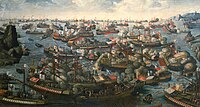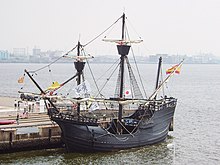Prehistory and antiquity

A raft is among the simplest boat designs.
By around 3000 BC, Ancient Egyptians knew how to assemble wooden planks into a hull.[9] They used woven straps to lash the planks together,[9] and reeds or grass stuffed between the planks helped to seal the seams.[9][10] The Greek historian and geographer Agatharchides had documented ship-faring among the early Egyptians: "During the prosperous period of the Old Kingdom, between the 30th and 25th centuries B. C., the river-routes were kept in order, and Egyptian ships sailed the Red Sea as far as the myrrh-country."[11] Sneferu's ancient cedar wood ship Praise of the Two Lands is the first reference recorded (2613 BCE) to a ship being referred to by name.[12]
The ancient Egyptians were perfectly at ease building sailboats. A remarkable example of their shipbuilding skills was the Khufu ship, a vessel 143 feet (44 m) in length entombed at the foot of the Great Pyramid of Giza around 2500 BC and found intact in 1954. According to Herodotus, the Egyptians made the first circumnavigation of Africa around 600 BC.
It is known that ancient Nubia/Axum traded with India, and there is evidence that ships from Northeast Africa may have sailed back and forth between India/Sri Lanka and Nubia trading goods and even to Persia, Himyar and Rome.[13] Aksum was known by the Greeks for having seaports for ships from Greece and Yemen.[14]
Elsewhere in Northeast Africa, the Periplus of the Red Sea reports that Somalis, through their northern ports such as Zeila and Berbera, were trading frankincense and other items with the inhabitants of the Arabian Peninsula well before the arrival of Islam as well as with then Roman-controlled Egypt.[15]
A panel found at Mohenjodaro, depicted a sailing craft. Vessels were of many types Their construction is vividly described in the Yukti Kalpa Taru, an ancient Indian text on shipbuilding. This treatise gives a technical exposition on the techniques of shipbuilding. It sets forth minute details about the various types of ships, their sizes,and the materials from which they were built. The Yukti Kalpa Taru sums up in a condensed form all the available information. The Yukti Kalpa Taru gives sufficient information and dates to prove that, in ancient times, Indian shipbuilders had a good knowledge of the materials which were used in building ships. In addition to describing the qualities of the different types of wood and their suitability for shipbuilding, the Yukti Kalpa Taru gives an elaborate classification of ships based on their size.
By about 2000 BC, the Minoan civilization in Crete had evolved into a naval power exercising effective control of the sea in the eastern Mediterranean.[16]
The Phoenicians and Greeks gradually mastered navigation at sea aboard triremes, exploring and colonizing the Mediterranean via ship. Around 340 BC, the Greek navigator Pytheas of Massalia ventured from Greece to Western Europe and Great Britain.[17] In the course of the 2nd century BC, Rome went on to destroy Carthage and subdue the Hellenistic kingdoms of the eastern Mediterranean, achieving complete mastery of the inland sea, that they called Mare Nostrum. The monsoon wind system of the Indian Ocean was first sailed by Greek navigator Eudoxus of Cyzicus in 118 BC.[18] With 300 Greek ships a year sailing between Roman Empire and India, the annual trade may have reached 300,000 tons.[19]
In China, by the time of the Zhou Dynasty ship technologies such as stern mounted rudders were developed, and by the Han Dynasty, a well kept naval fleet was an integral part of the military. Ship technology advanced to the point where by the medieval period, water tight compartments were developed.
The Swahili people had various extensive trading ports dotting the coast of medieval East Africa and Great Zimbabwe had extensive trading contacts with Central Africa, and likely also imported goods brought to Africa through the Southeast African shore trade of Kilwa in modern-day Tanzania.[20]
It is known by historians that at its height the Mali Empire built a large naval fleet under Emperor Mansa Musa in the late 13th and early 14th century.[21] Arabic sources describe what some consider to be visits to the New World by a Mali fleet in 1311.[22]

The Battle of Lepanto, 1571, naval engagement between allied Christian forces and the Ottoman Turks.
Renaissance
Until the Renaissance, navigational technology remained comparatively primitive. This absence of technology did not prevent some civilizations from becoming sea powers. Examples include the maritime republics of Genoa and Venice, Hanseatic League, and the Byzantine navy. The Vikings used their knarrs to explore North America, trade in the Baltic Sea and plunder many of the coastal regions of Western Europe.Towards the end of the 14th century, ships like the carrack began to develop towers on the bow and stern. These towers decreased the vessel's stability, and in the 15th century, the caravel, designed by the Portuguese, based on the Arabic qarib which could sail closer to the wind, became more widely used. The towers were gradually replaced by the forecastle and sterncastle, as in the carrack Santa María of Christopher Columbus. This increased freeboard allowed another innovation: the freeing port, and the artillery associated with it.

A Japanese atakebune from the 16th century
At this time, ships were developing in Asia in much the same way as Europe. Japan used defensive naval techniques in the Mongol invasions of Japan in 1281. It is likely that the Mongols of the time took advantage of both European and Asian shipbuilding techniques. During the 15th century, China's Ming Dynasty assembled one of the largest and most powerful naval fleet in the world for the diplomatic and power projection voyages of Zheng He. Elsewhere in Korea in the 15th century, one of the world's first iron-clads, the turtle ship, was also developed. In Japan, during the Sengoku era from the fifteenth to 17th century, the great struggle for feudal supremacy was fought, in part, by coastal fleets of several hundred boats, including the atakebune.
During the Age of the Ajuuraan, the Somali sultanates and republics of Merca, Mogadishu, Barawa, Hobyo and their respective ports flourished, enjoying a lucrative foreign commerce with ships sailing to and coming from Arabia, India, Venetia,[26] Persia, Egypt, Portugal and as far away as China. In the 16th century, Duarte Barbosa noted that many ships from the Kingdom of Cambaya in what is modern-day India sailed to Mogadishu with cloth and spices, for which they in return received gold, wax and ivory. Barbosa also highlighted the abundance of meat, wheat, barley, horses, and fruit on the coastal markets, which generated enormous wealth for the merchants.[27]
Middle Age Swahili Kingdoms are known to have had trade port islands and trade routes[28] with the Islamic world and Asia and were described by Greek historians as "metropolises".[29] Famous African trade ports such as Mombasa, Zanzibar, and Kilwa[30] were known to Chinese sailors such as Zheng He and medieval Islamic historians such as the Berber Islamic voyager Abu Abdullah ibn Battua.[31] In the 14th century CE King Abubakari I, the brother of King Mansa Musa of the Mali Empire is thought to have had a great armada of ships sitting on the coast of West Africa.[32] This is corroborated by ibn Battuta himself who recalls several hundred Malian ships off the coast.[33] This has led to great speculation, with historical evidence, that it is possible that Malian sailors may have reached the coast of Pre-Columbian America under the rule of Abubakari II, nearly two hundred years before Christopher Columbus[34] and that black traders may have been in the Americas before Columbus.[35]

Replica of Magellan’s Victoria. Ferdinand Magellan led the first expedition that circumnavigated the globe in 1519-1522.
The carrack and then the caravel were developed in Iberia. After Columbus, European exploration rapidly accelerated, and many new trade routes were established.[36] In 1498, by reaching India, Vasco da Gama proved that the access to the Indian Ocean from the Atlantic was possible. These explorations in the Atlantic and Indian Oceans were soon followed by France, England and the Netherlands, who explored the Portuguese and Spanish trade routes into the Pacific Ocean, reaching Australia in 1606 and New Zealand in 1642.[37] A major sea power, the Dutch in 1650 owned 16,000 merchant ships.[38] In the 17th century Dutch explorers such as Abel Tasman explored the coasts of Australia, while in the 18th century it was British explorer James Cook who mapped much of Polynesia.
Specialization and modernization

The British HMS Sandwich fires to the French flagship Bucentaure (completely dismasted) into battle off Trafalgar. The Bucentaure also fights HMS Victory (behind her) and HMS Temeraire (left side of the picture). In fact, HMS Sandwich never fought at Trafalgar, it's a mistake from Auguste Mayer, the painter.[39]
Maritime trade was driven by the development of shipping companies with significant financial resources. Canal barges, towed by draft animals on an adjacent towpath, contended with the railway up to and past the early days of the industrial revolution. Flat-bottomed and flexible scow boats also became widely used for transporting small cargoes. Mercantile trade went hand-in-hand with exploration, self-financed by the commercial benefits of exploration.
During the first half of the 18th century, the French Navy began to develop a new type of vessel known as a ship of the line, featuring seventy-four guns. This type of ship became the backbone of all European fighting fleets. These ships were 56 metres (184 ft) long and their construction required 2,800 oak trees and 40 kilometres (25 mi) of rope; they carried a crew of about 800 sailors and soldiers.
During the 19th century the Royal Navy enforced a ban on the slave trade, acted to suppress piracy, and continued to map the world. A clipper was a very fast sailing ship of the 19th century. The clipper route fell into commercial disuse with the introduction of steam ships, and the opening of the Suez and Panama Canals.
Ship designs stayed fairly unchanged until the late 19th century. The industrial revolution, new mechanical methods of propulsion, and the ability to construct ships from metal triggered an explosion in ship design. Factors including the quest for more efficient ships, the end of long running and wasteful maritime conflicts, and the increased financial capacity of industrial powers created an avalanche of more specialized boats and ships. Ships built for entirely new functions, such as firefighting, rescue, and research, also began to appear.
In light of this, classification of vessels by type or function can be difficult. Even using very broad functional classifications such as fishery, trade, military, and exploration fails to classify most of the old ships. This difficulty is increased by the fact that the terms such as sloop and frigate are used by old and new ships alike, and often the modern vessels sometimes have little in common with their predecessors.
Today

The Colombo Express, one of the largest container ships in the world, owned and operated by Hapag-Lloyd of Germany
In 2002, there were 1,240 warships operating in the world, not counting small vessels such as patrol boats. The United States accounted for 3 million tons worth of these vessels, Russia 1.35 million tons, the United Kingdom 504,660 tons and China 402,830 tons. The 20th century saw many naval engagements during the two world wars, the Cold War, and the rise to power of naval forces of the two blocs. The world's major powers have recently used their naval power in cases such as the United Kingdom in the Falkland Islands and the United States in Iraq.
The size of the world's fishing fleet is more difficult to estimate. The largest of these are counted as commercial vessels, but the smallest are legion. Fishing vessels can be found in most seaside villages in the world. As of 2004, the United Nations Food and Agriculture Organization estimated 4 million fishing vessels were operating worldwide.[41] The same study estimated that the world's 29 million fishermen[42] caught 85,800,000 tonnes (84,400,000 long tons; 94,600,000 short tons) of fish and shellfish that year.[43]




